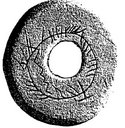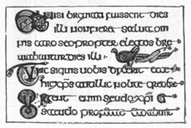
The Book of Kells. An Irish Medieval Manuscript
‘Celtic’ is a linguistic term (pronounced with a hard ‘c’) which describes a group of languages nowadays represented by Irish (Gaelige), Gaelic (Gàídhlig, the descendant of Scots-Irish) and Manx (Gailck), belonging to the ‘q’ Celtic group Goidelic (as the old Celtic Irish were called), and Welsh, Breton and Cornish, which make up the ‘p’ Celtic group known as Brittonic or Brythonic). It is customary to distinguish ‘Q’ – Celts from the P – Celts, the Goidelic speakers having lost the capacity or inclination to pronounce initial ‘p’s, so either dropped it completely (‘pater’ in Latin, meaning ‘father’, is ‘athair’ in modern Irish) or changed it to a ‘q’ type sound, thus ‘purpura’ in Latin, meaning ‘purple’, is ‘corcora’ in Irish.
The name for the Irish Language in Gaelic is ‘Gaeilge’ (pronounced ‘Gay-il-gheh’). The Goidelic branch is spoken mainly in Ireland as a living language on its western fringes and in the highlands and western Isles of Scotland. The last native speaker of Manx died in 1974, but there is a small movement on the Isle of Man to try and revive the language.
Gaelic was introduced to Scotland some time in the 5th century AD, when settlers from north – eastern Ireland established a new kingdom Dal Riada (pronounced ‘Doll ree-ada’) in the western district of Arygll. Speakers of Irish can understand Scots Gaelic, but will not be able to understand Welsh or Breton, as the two groups of languages have been developing separately for over 2,000 years.
At its greatest, what is sometimes viewed as ‘the Celtic world’ stretched from Ireland in the west to Turkey in the east, leaving traces in Turkey in the province of Galatia, and in Spain in the province of Galicia, where a Celtic dialect survives today in the form of Gallego (pronounced ‘Gal-yay-go’).
The Brythonic branch includes Welsh (spoken in Wales), Cornish (spoken in Cornwall until World War Two), and Breton (spoken in the region of Brittany in the north-west of France). Brythonic is also called p-Celtic because the ‘kw’ sound had developed into a ‘p’ (or ‘b’). The Welsh for son is map or mab, the root word of Mabinogion a collection of ancient Welsh legends including some of King Arthur.
It is not known when the Celts arrived in Ireland (dates vary from 2000 BC to about 500 BC), neither is it known when Irish became the foremost language of the majority of people on the island of Ireland. Nonetheless some different periods in the life of the language can be identified:
Ogam Irish 5th – 7th centuries
Ogam Inscription (Orkney):
Old Irish: 7th – 9th centuries
Irish writing of 8th Century:
Middle Irish: 900 – 1200
Classical Irish: 1200 – 1600
Modern (now standardised) Irish: 1600 – to the present time.
From the 9th century various invaders and settlers introduced their own languages. The Vikings brought Norse, which was spoken for hundreds of years in the towns and cities they established, such as Dublin (traces of which could be found in the old Liberties area well into the 20th century), Waterford and Limerick. Later, in the same way, Norman French was spoken in cities like Kilkenny, and Galway. Some of the southern dialects of Irish are still detectably influenced by Norman French, and contain several typically French words like ‘garsun’ boy, (modern French ‘garcon’). Flemish was spoken in parts of counties Wexford and Waterford, German through Palatine influence in West Limerick However it was Hiberno – English, which, by the latter quarter of the 19th century had come to be the dominant spoken and written tongue.
Although the Irish Language began to go into decline after the demise of the native Aristocracy in the early years of the 17th Century, it was not until the 19th century after the Act of Union, whereby Ireland and England became a single political and economic entity that the decline accelerated.
What became known as the Great Famine (1845-48) had an enormous effect on the Irish language. At least one million people died of starvation or disease. Another million emigrated, most going to English-speaking countries, England, Australia, and particularly the United States of America. Subsequently, among the native Irish people, attitudes to the English Language changed. The children of those who spoke Irish were encouraged to learn English as this was now seen as the language for economic and social survival and advancement.
The massive emigration that continued in the decades after the famine, mainly from Irish speaking areas, meant that by 1891, 85 per cent of Irish people spoke English and of around 680,000 who could still speak Irish the majority, except for a few isolated islands and regions, were bi-lingual.
At the beginning of the 19th century, scholars, particularly German, became interested in studying Old Irish and towards the end of the century there arose what has become known as the Celtic revival, which was an attempt to establish a national Irish identity. Conradh na Gaelige (The Gaelic league) was founded in 1893 with the principle aim of reviving the Irish language. With the foundation of the new Irish State, Saorstát Éireann in 1922, the principles advocated by the Gaelic League became the new government’s policy. Irish was recognised as the first official language and all aspects of administration were handled bilingually.
However, in spite of various attempts, including a new alphabet, a national standardisation of the language, and compulsory Irish classes in primary and secondary schools, the language continued to decline, even in the designated Gaelteacht (Irish speaking) areas situated manily in Kerry, Galway and Donegal.
Today, there is some revival in progress. Interesting developments are the increasing numbers of parents who are sending their children to ‘Naíonraí’ (pronounced ‘Nee-un-ree’), which are Irish-speaking crèches, also the growth in the number of Gaelscoileanna (Irish schools). These are schools in which Irish is the language of education. One of the biggest influences was the establishing of TG4, the Irish television station, in 1996. Seán Tadhg Ó Gairbhí, editor of the weekly newspaper Foinse stated, “TG4 has brought about a fundamental shift in attitude towards the language, and consequently has led to an increased self confidence among Irish language speakers.” It has also helped the language to break free of association with narrow-minded nationalism, both cultural and political.
There is also a revival taking place amongst the descendents of the millions who emigrated, and new interest in countries such as Hungary and Japan. Channel 4 recently put out a programme on the teaching of Irish in night classes in Liverpool. The students are usually, but by no means always, people of Irish descent whose forebears had immigrated to Liverpool after the Famine. Liverpool was often the first stop for destitute emigrants, who intended to work for a while in the city until they had earned enough to buy their passage to America.
Another TV programme about the teaching of English in Poland by Irish teachers showed that such was the demand from Poles to learn Irish, that some of these teachers ended up teaching classes in both languages!
A curious story emerged in the course of research for an RTE TV programme about little known communities in Argentina. The forebears of these people were well-to-do farmers from the South East of Ireland, who had immigrated to Argentina prior to the Famine. In Argentina they were able to acquire vast ranches at a fraction of the cost of land in Ireland, and there were much greater prospects of getting rich. What interested the researchers was that the Irish Language had survived there amongst people who had never been to Ireland! The language has also of course survived in Canada, particularly Nova Scotia. Closer to home, a recent RTE programme investigating the level of interest in Ireland in learning the Irish language showed a night class in which students of the language included several from Africa, and Eastern Europe. Whilst membership of the EU confers or reaffirms statehood, a sense of security, and protection from larger, ancient enemies, those who study history know that the tendency of the larger political entity is towards obliterating cultural and linguistic differences in the interests of administrative efficiency. Minority languages are now increasingly seen as the keys to heritage, the past, the roots and psyche of a nation. The revival in Ireland itself is part of a general revival of their languages by ethnic groups all across Europe. It is seen as an essential element in restoring a sense of identity, in a world where economic and political considerations have dominated in recent years.
John Killeen

